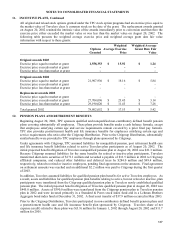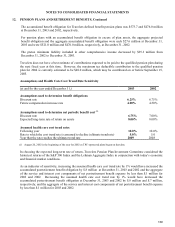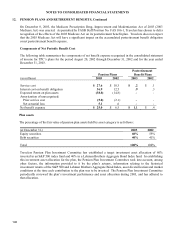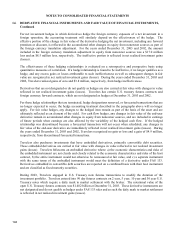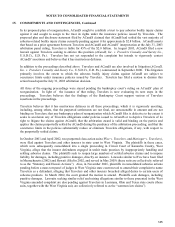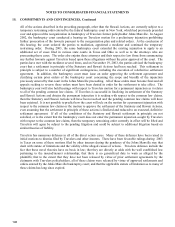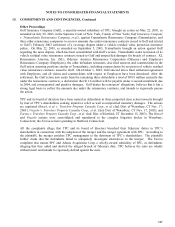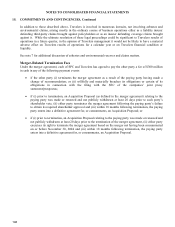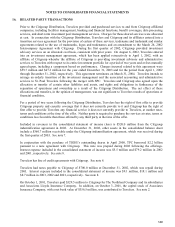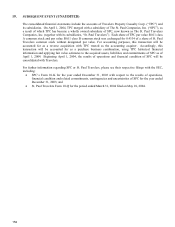Travelers 2003 Annual Report Download - page 148
Download and view the complete annual report
Please find page 148 of the 2003 Travelers annual report below. You can navigate through the pages in the report by either clicking on the pages listed below, or by using the keyword search tool below to find specific information within the annual report.146
NOTES TO CONSOLIDATED FINANCIAL STATEMENTS
15. COMMITMENTS AND CONTINGENCIES, Continued
All of the actions described in the preceding paragraph, other than the Hawaii Actions, are currently subject to a
temporary restraining order entered by the federal bankruptcy court in New York, which had previously presided
over and approved the reorganization in bankruptcy of Travelers former policyholder Johns Manville. In August
2002, the bankruptcy court conducted a hearing on Travelers motion for a preliminary injunction prohibiting
further prosecution of the lawsuits pursuant to the reorganization plan and related orders. At the conclusion of
this hearing, the court ordered the parties to mediation, appointed a mediator and continued the temporary
restraining order. During 2003, the same bankruptcy court extended the existing injunction to apply to an
additional set of cases filed in various state courts in Texas and Ohio as well as to the attorneys who are
prosecuting these cases. The order also enjoins these attorneys and their respective law firms from commencing
any further lawsuits against Travelers based upon these allegations without the prior approval of the court. The
parties have met with the mediator several times, and on November 19, 2003, the parties advised the bankruptcy
court that a settlement in principle of the Statutory and Hawaii Actions had been reached. This settlement in
principle is subject to a number of significant contingencies, including the execution of a definitive settlement
agreement. In addition, the bankruptcy court must issue an order approving the settlement agreement and
clarifying certain prior orders of the bankruptcy court concerning the scope and breadth of the injunction
previously entered by that court in the Johns Manville proceeding. All of these orders must become final and all
appeals seeking to reverse these orders must have been denied in order for the settlement to take effect. The
bankruptcy court will also hold hearings with respect to Travelers motion for a permanent injunction as it relates
to all of the pending common law claims. If Travelers is successful in finalizing its settlement of the Statutory
and Hawaii Actions and obtains the permanent injunction it is seeking with respect to the common law claims,
then the Statutory and Hawaii Actions will have been resolved and the pending common law claims will have
been enjoined. It is not possible to predict how the court will rule on the motion for a permanent injunction with
respect to the common law claims or the motion to approve the settlement of the Statutory and Hawaii Actions,
even assuming that the settlement in principle of these actions is finalized and reduced to an executed, definitive
settlement agreement. If all of the conditions of the Statutory and Hawaii settlement in principle are not
satisfied, or to the extent that the bankruptcy court does not enter the permanent injunction sought by Travelers
with respect to the common law claims, then the temporary restraining order currently in effect will be lifted and
Travelers will again be subject to the pending litigation and could be subject to additional litigation based on
similar theories of liability.
Travelers has numerous defenses in all of the direct action cases. Many of these defenses have been raised in
initial motions to dismiss filed by Travelers and other insurers. There have been favorable rulings during 2003
in Texas on some of these motions filed by other insurers during the pendency of the Johns Manville stay that
dealt with statute of limitations and the validity of the alleged causes of actions. Travelers defenses include the
fact that these novel theories have no basis in law; that they are directly at odds with the well established law
pertaining to the insured/insurer relationship; that there is no generalized duty to warn as alleged by the
plaintiffs; that to the extent that they have not been released by virtue of prior settlement agreements by the
claimants with Travelers policyholders, all of these claims were released by virtue of approved settlements and
orders entered by the Johns Manville bankruptcy court; and that the applicable statute of limitation as to many of
these claims has long since expired.



